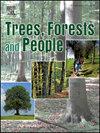Creating, enhancing, and capturing environmental product values – Medicinal and spice plant trade in the Himalayan foothills
IF 2.7
Q1 FORESTRY
引用次数: 0
Abstract
There is a substantial trade in renewable environmental products, including medicinal and spice plants. Yet, their production networks remain largely unknown. Here, using a global production network approach, we unravel the trade for such products in the Himalayan foothills of Nepal, focusing on how values are created, enhanced, and captured. We conducted quantitative interviews with harvesters (n = 25), traders (n = 12), and central wholesalers (n = 2) in 2014–15 and with traders (n = 5) in 2021–22 in Kailali District of Sudurpaschim Province, Nepal. All traders from the district were interviewed in both case years. We found that harvesters created and enhanced value by wild-harvesting, cultivating, and air-drying 10 products from nine species in 2014–15 and 14 products from 13 species in 2021–22. The total annual trade increased from 151 to 340 tons in the period, and the value rose from USD 103,939 to USD 125,800 (in 2021–22 prices). The trade was dominated by the cultivated tejpat leaves (Cinnamomum tamala) and the leaves of kadipatta (Murraya koenigii) in 2021–22. Traders and central wholesalers enhanced value through transport, not processing. Secondary processing in the district was limited, resulting in missed opportunities for added value through processing. Non-firm actors captured value in connection to issuing collection, trade, and export permits. An average of 68 % of volume and 86 % of harvester value were sourced from cultivation, showing the growing importance of these species for supplementary rural income in the lowlands. The process of increased commercialisation reflects similar changes in the neighbouring countries. Finally, we conclude that the global production network approach can be applied to examine the dynamics of South-South trade in renewable environmental products, even in the absence of a lead firm.
创造、提升和获取环境产品价值——喜马拉雅山麓的药用和香料植物贸易
包括药用和香料植物在内的可再生环境产品有大量贸易。然而,它们的生产网络在很大程度上仍不为人所知。在这里,我们使用全球生产网络方法,揭示了尼泊尔喜马拉雅山麓地区这类产品的贸易,重点关注如何创造、增强和捕获价值。我们在2014 - 2015年对收获者(n = 25)、贸易商(n = 12)和中央批发商(n = 2)进行了定量访谈,并在2021 - 2022年对尼泊尔苏杜尔帕希姆省Kailali地区的贸易商(n = 5)进行了定量访谈。在这两个年份,该地区的所有商人都接受了采访。研究发现,2014 - 2015年,采收者通过野生采收、培育和风干9个品种的10种产品,以及2021-22年,采收者通过野生采收、培育和风干13个品种的14种产品,创造和提升了价值。在此期间,年贸易总量从151吨增加到340吨,价值从103,939美元增加到125,800美元(以2021-22年价格计算)。2021 - 2022年,贸易以种植的tejpat叶(Cinnamomum tamala)和kadipatta叶(Murraya koenigii)为主。贸易商和中央批发商通过运输而不是加工来提高价值。区内二次加工有限,错失了加工增值的机会。非企业行为体在发放收款、贸易和出口许可证方面获得了价值。平均68%的产量和86%的收获价值来自种植,这表明这些物种对低地农村的补充收入越来越重要。日益商业化的过程反映了邻国的类似变化。最后,我们得出结论,全球生产网络方法可以应用于研究可再生环境产品的南南贸易动态,即使在没有领导公司的情况下。
本文章由计算机程序翻译,如有差异,请以英文原文为准。
求助全文
约1分钟内获得全文
求助全文
来源期刊

Trees, Forests and People
Economics, Econometrics and Finance-Economics, Econometrics and Finance (miscellaneous)
CiteScore
4.30
自引率
7.40%
发文量
172
审稿时长
56 days
 求助内容:
求助内容: 应助结果提醒方式:
应助结果提醒方式:


